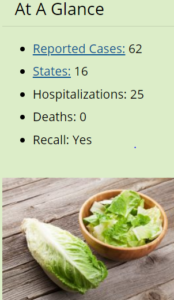Another Romaine lettuce outbreak takes its toll
I occasionally write about disease outbreaks caused by food and am especially interested in those caused by romaine lettuce, because it’s so hard to trace back where it came from and how it got contaminated.
This post is about two outbreaks of toxic E. coli O157:H7 from Romaine lettuce.
Outbreak #1: This one pretty much ended in November 2018. My post on it is here. The CDC’s page on it is here.
It was especially serious:
- 210 reported illnesses from 36 states
- 96 hospitalizations
- 27 cases of hemolytic uremic syndrome (HUS)
- 5 deaths
Food safety lawyer Bill Marler posted a slide show analyzing this outbreak on his website: “Thanks to FOIA, the CDC and FDA, the 2018 E. coli Romaine Outbreak becoming more Transparent.” At least that.
Outbreak #2. In February, the FDA published its “Investigation Summary: Factors Potentially Contributing to the Contamination of Romaine Lettuce Implicated in the Fall 2018 Multi-State Outbreak of E. coli O157:H7.”
The FDA’s web page on this outbreak is here, and the CDC’s is here.

Bill Marler, whose firm represents victims of these outbreaks, posted annotated comments on the announcement. He titled his post: “The FDA to Leafy Green Growers – “Please voluntarily stop poisoning your customers.”
Despite finding that E. coli outbreaks spanning years likely came from the same are or farm and was most likely caused by the same factors enumerated above, the FDA only sets forth “recommendations” that growers of leafy greens assess their growing operations for compliance with applicable requirements of the FSMA Produce Safety Rule and GAPs, including (see my snide comments in bold).
I will just give one example of his comments:
FDA continues to recommend (suggest, plead, beg, whine) that leafy green growers, buyer/shippers, and retailers be able to trace product back to the specific source in real time and make information about the source, such as harvest date and standardized growing regions, readily available for consumers on either packaging, point of sale signs, or by other means.
Voluntary, alas, isn’t good enough. The FDA needs authority to require, demand, insist on. Now.
If you want to see what this is about, take a look at the documents:
- FDA’s final guidance for leafy green growers is here.
- FDA guidance documents for leafy green growers are posted here. There are lots of them.
- FDA guidance documents for retailers selling leafy greens are posted here.

